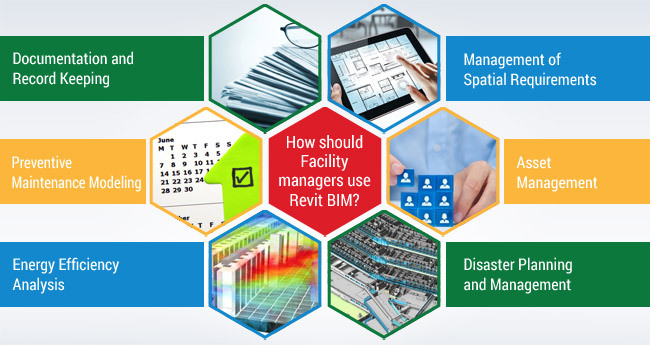How should Facility managers use Revit BIM?
Contents |
[edit] Introduction
Revit Autodesk, is building design software that is specifically built for building information modelling (BIM). It includes features for architectural, mechanical, electrical and plumbing (MEP) and structural engineering disciplines. Revit is not facility management software - however it provides several tools that allow users (facility managers) to explore, track and manage facility information. These tools support facility managers in their use of BIM to analyse spatial information, track inventories, perform cost analysis and so on.
This is BIM as building information management rather than building information modeling, used for a variety of applications for the operation and maintenance of a facility as described below:
[edit] Documentation and record keeping
The model that is provided to the facility manager serves as a document that contains highly detailed and accurate information about the facility. It not only includes data pertaining to the architectural, structural and MEP disciplines, but also contains details such as design and construction information, 4D coordination models and fabrication models. It also includes facility information like serial codes, warranties, operational data, maintenance history of individual components of the building and so on.
As a facility ages and undergoes spatial changes, renovation work and maintenance operations the building information is then updated in the model, so that it can be effectively used for future renovations and facility management.
[edit] Preventive maintenance modelling
Facility managers can use BIM to plan maintenance activities. It can be used to evaluate a situation and take informed decisions about repair work, renovations, refurbishments, spatial changes and so on. As a result the need for emergency repairs and corrective maintenance reduces. This in turn reduces the need for repeated repairs and maintenance, improves the performance of the facility, improves occupant comfort and reduces the amount spent on O&M activities.
[edit] Energy efficiency analysis
Facility managers can use BIM to compare the predicted performance of building systems with actual performance and ensure that sustainability standards are maintained. BIM data can be used to analyse and validate the performance of individual systems, report discrepancies and evaluate the impact of any proposed changes to improve performance.
[edit] Management of spatial requirements
In an occupied facility, spatial requirements may need to be changed over time. Using BIM with detailed spatial information allows facility managers to make the best use of available space and plan in advance for future space requirements.
[edit] Asset management
Data in BIM can be linked with building asset databases and used for O&M activities like short-term or long-term planning, maintenance scheduling, making informed financial decisions for O&M and so on. BIM can also be used to manage assets, evaluate the implications of changing and upgrading building assets, produce accurate quantity take offs etc.
[edit] Disaster Planning and Management
BIM gives facility managers information to brace up and prepare facilities to face and overcome disasters and emergency situations. This can be done by combining information such as MEP systems, equipment schematics, floor plans etc and retrieving real-time information via building automation systems. BIM can also be used to analyse the situation, detect the source of emergency situations as they arise and plan measures accordingly.
This article was created by --Bhushanavsatthi
ANJANI DANGRE
[edit] Related articles on Designing Buildings
Featured articles and news
The UK's Modern Industrial Strategy: A 10 year plan
Previous consultation criticism, current key elements and general support with some persisting reservations.
Building Safety Regulator reforms
New roles, new staff and a new fast track service pave the way for a single construction regulator.
Architectural Technologist CPDs and Communications
CIAT CPD… and how you can do it!
Cooling centres and cool spaces
Managing extreme heat in cities by directing the public to places for heat stress relief and water sources.
Winter gardens: A brief history and warm variations
Extending the season with glass in different forms and terms.
Restoring Great Yarmouth's Winter Gardens
Transforming one of the least sustainable constructions imaginable.
Construction Skills Mission Board launch sector drive
Newly formed government and industry collaboration set strategy for recruiting an additional 100,000 construction workers a year.
New Architects Code comes into effect in September 2025
ARB Architects Code of Conduct and Practice available with ongoing consultation regarding guidance.
Welsh Skills Body (Medr) launches ambitious plan
The new skills body brings together funding and regulation of tertiary education and research for the devolved nation.
Paul Gandy FCIOB announced as next CIOB President
Former Tilbury Douglas CEO takes helm.
UK Infrastructure: A 10 Year Strategy. In brief with reactions
With the National Infrastructure and Service Transformation Authority (NISTA).
Ebenezer Howard: inventor of the garden city. Book review.
The Grenfell Tower fire, eight years on
A time to pause and reflect as Dubai tower block fire reported just before anniversary.
Airtightness Topic Guide BSRIA TG 27/2025
Explaining the basics of airtightness, what it is, why it's important, when it's required and how it's carried out.
Construction contract awards hit lowest point of 2025
Plummeting for second consecutive month, intensifying concerns for housing and infrastructure goals.
Understanding Mental Health in the Built Environment 2025
Examining the state of mental health in construction, shedding light on levels of stress, anxiety and depression.























